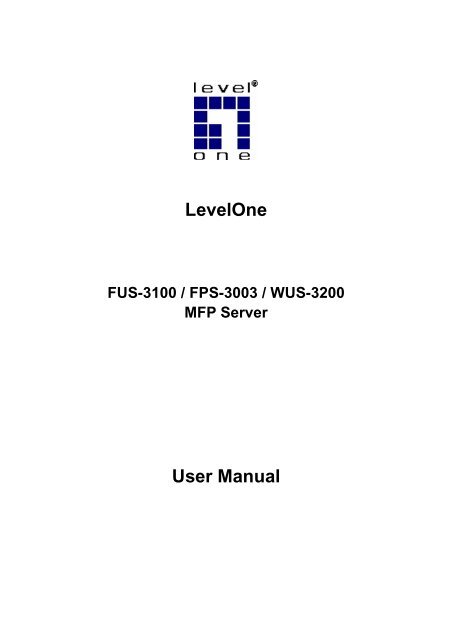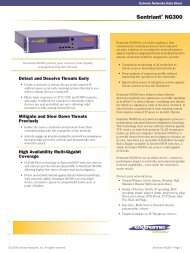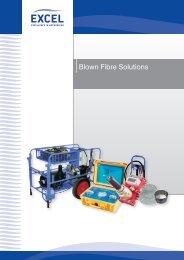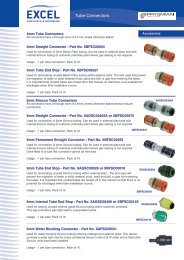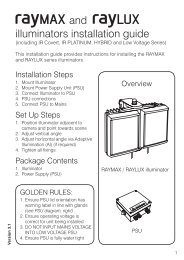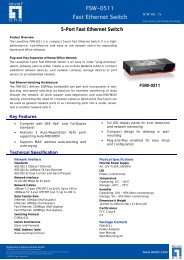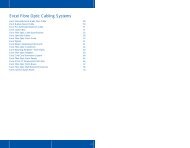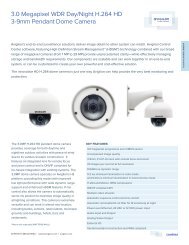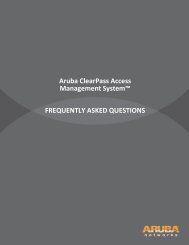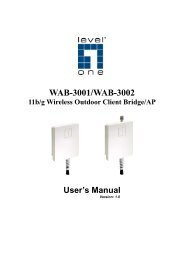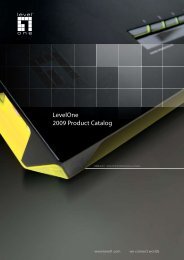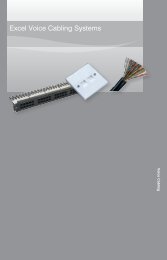MFP Server User Manual - LevelOne
MFP Server User Manual - LevelOne
MFP Server User Manual - LevelOne
You also want an ePaper? Increase the reach of your titles
YUMPU automatically turns print PDFs into web optimized ePapers that Google loves.
<strong>LevelOne</strong>FUS-3100 / FPS-3003 / WUS-3200<strong>MFP</strong> <strong>Server</strong><strong>User</strong> <strong>Manual</strong>
SafetyFCC WARNINGThis equipment may generate or use radio frequency energy. Changes or modifications to this equipment may cause harmful interference unlessthe modifications are expressly approved in the instruction manual. The user could lose the authority to operate this equipment if an unauthorizedchange or modification is made.This equipment has been tested and found to comply with the limits for a Class B digital device, pursuant to Part 15 of the FCC Rules. Theselimits are designed to provide reasonable protection against harmful interference in a residential installation. This equipment generates, uses,and can radiate radio frequency energy and, if not installed and used in accordance with the instructions, may cause harmful interference to radiocommunications. However, there is no guarantee that interference will not occur in a particular installation. If this equipment does cause harmfulinterference to radio or television reception, which can be determined by turning the equipment off and on, the user is encouraged to try to correctthe interference by one or more of the following measures:1) Reorient or relocate the receiving antenna.2) Increase the separation between the equipment and receiver.3) Connect the equipment into an outlet on a circuit different from that to which the receiver is connected.4) Consult the dealer or an experienced radio/TV technician for help.CE Declaration of conformityThis equipment complies with the requirements relating to electromagnetic compatibility, EN 55022 class B for ITE, the essential protectionrequirement of Council Directive 89/336/EEC on the approximation of the laws of the Member States relating to electromagnetic compatibility.CE Marking WarningHereby, Digital Data Communications, declares that this (Model-no. WUS-3200) is in compliance with the essential requirements and otherrelevant provisions of Directive 1999/5/EC.The CE-Declaration of Conformity can be downloaded at:http://www.levelone.eu/support.php2
Table of ContentsINTRODUCTION .........................................................................................................................6ABOUT THIS MANUAL...................................................................................................................6CUSTOMER SUPPORT..................................................................................................................61. PRODUCT OVERVIEW........................................................................................................7PACKAGE CONTENTS...................................................................................................................7PRODUCT CD.............................................................................................................................7START-UP PROCEDURES..............................................................................................................7PHYSICAL DESCRIPTION ..............................................................................................................7CONFIGURATION AND MANAGEMENT .............................................................................................8FEATURES AND BENEFITS ............................................................................................................82. BASIC INSTALLATION........................................................................................................9CONNECTING THE HARDWARE......................................................................................................9ASSIGNING AN IP ADDRESS TO THE SERVER..................................................................................9Preliminary............................................................................................................................9IP Address.............................................................................................................................9Host Names and Host Name Rules ....................................................................................10Setting the IP Address Using DHCP ...................................................................................10Setting the IP Address Using the Control Center ................................................................10Setting the IP Address Using <strong>MFP</strong> <strong>Server</strong>’s Web Pages ....................................................13WIRELESS CONFIGURATION........................................................................................................15Preliminary..........................................................................................................................15Set Wireless Configuration Using <strong>MFP</strong> <strong>Server</strong> Control Center ...........................................15Set Wireless Configuration Using <strong>MFP</strong> <strong>Server</strong>’s Web Page ...............................................193. USING THE <strong>MFP</strong> SERVER ................................................................................................23INTRODUCTION TO THE NEW TECHNOLOGY OF <strong>MFP</strong> SERVER........................................................23CONNECT & DISCONNECT..........................................................................................................23HOW TO USE ............................................................................................................................24Driver Installation ................................................................................................................24Set Auto-Connect Printer ....................................................................................................26<strong>Manual</strong>-Connect Scanner ...................................................................................................293
Auto-Connect Scanner........................................................................................................31<strong>Manual</strong>-Connect / Auto-Connect Fax..................................................................................32MANUAL-CONNECT VS AUTO-CONNECT .....................................................................................34LIMITATIONS..............................................................................................................................35CONNECTING PERIOD FOR AUTO CONNECT AND MANUAL CONNECT..............................................354. THE CONTROL CENTER UTILITY....................................................................................36INSTALLING CONTROL CENTER UTILITY.......................................................................................36USING THE CONTROL CENTER UTILITY........................................................................................36Using Tools of Control Center Utility ...................................................................................36Displaying <strong>MFP</strong> <strong>Server</strong> Status ............................................................................................37Setting up <strong>MFP</strong> <strong>Server</strong> Configuration .................................................................................37QUITTING THE CONTROL CENTER UTILITY...................................................................................425. FILE SERVER ....................................................................................................................43PRELIMINARY............................................................................................................................43STORAGE NAMES......................................................................................................................44CONNECTING USB MASS STORAGE TO THE SERVER ...................................................................44SUPPORTED CODEPAGES ..........................................................................................................44What is codepage? .............................................................................................................44Filename Encoding of FAT File System..............................................................................44When do you need to configure codepage? .......................................................................45Configuring the <strong>Server</strong>’s Codepages ..................................................................................45ADDING USB MASS STORAGES TO NETWORK WITH SECURITY .....................................................47Setting up File <strong>Server</strong> Using the Control Center Utility .......................................................48Setting up File <strong>Server</strong> Using Web Pages............................................................................50Using Shared Storages by SMB/CIFS Method for Windows...............................................51Using Shared Storage by FTP Methods for Windows .........................................................536. <strong>MFP</strong> SERVER’S WEB PAGES...........................................................................................54INTRODUCTION .........................................................................................................................54USING THE SERVER’S WEB PAGES .............................................................................................54Displaying <strong>Server</strong> Status.....................................................................................................54Setting up <strong>Server</strong> Configuration..........................................................................................557. UPGRADE FIRMWARE .....................................................................................................57PROCEDURE A: USING THE CONTROL CENTER UTILITY ................................................................574
8. RESTORE FACTORY DEFAULTS .....................................................................................59USING THE CONTROL CENTER UTILITY........................................................................................59USING THE SERVER’S WEB PAGES .............................................................................................59USING INIT BUTTON...................................................................................................................60DEFAULT PARAMETERS LIST.......................................................................................................609. THE INIT BUTTON .............................................................................................................6210. TROUBLESHOOTING.......................................................................................................63LED INDICATORS ......................................................................................................................63IF AUTO-CONNECT DOES NOT WORK...........................................................................................63FIREWALL.................................................................................................................................635
IntroductionThank you for purchasing <strong>LevelOne</strong> <strong>MFP</strong> <strong>Server</strong> (in the following referred to as “<strong>MFP</strong><strong>Server</strong>”). The <strong>MFP</strong> <strong>Server</strong> is designed to connect with All-In-One device or MultifunctionPeripheral such as printers, and scanners, to the network, allowing all network users to accessthe USB devices.About this <strong>Manual</strong>This manual provides introductory information as well as detailed instructions on how to set upand manage <strong>MFP</strong> <strong>Server</strong> in various network environments. <strong>LevelOne</strong> offers 3 models of <strong>MFP</strong><strong>Server</strong>; all models have a 10/100Mbps LAN port. However, FUS-3100 has only one USB port,while both FPS-3003 and WUS-3200 have two USB ports. Compared with FPS-3003,WUS-3200 offers an additional wireless module (802.11b/g). Except for the wirelessconfiguration, most configuration and operations are similar between all models. Unless explicitlyspecified, all instructions in this user manual apply to <strong>LevelOne</strong> <strong>MFP</strong> <strong>Server</strong>s.To fully benefit from this document, user should be familiar with basic networking principles. Theinstructions described in this manual are based on the setup for new <strong>MFP</strong> <strong>Server</strong>. To reload theFactory Parameters, user can reset this <strong>MFP</strong> <strong>Server</strong> back to Factory Default, which will restoremost of the settings. For details, please refer to the chapter “Restore Factory Defaults”.Customer SupportShould you require any technical assistance, please contact with your local dealer. Or pleasevisit our website at http://www.level1.com for latest product information.This document is subject to changes without prior notice.6
1. Product OverviewPackage ContentsVerify that nothing is missing from the package by using the checking list below. Please contactyour local dealer if anything is missing or damaged. All packing materials are recyclable. Pleaseconfirm the items in the package below:● <strong>MFP</strong> <strong>Server</strong> (FUS-3100 / FPS-3003 / WUS-3200)● Power Adapter● CD <strong>Manual</strong>/Utility●Quick Installation GuideProduct CDThe CD contains <strong>MFP</strong> <strong>Server</strong> Control Center software, <strong>User</strong> <strong>Manual</strong> and Quick InstallationGuide.Start-up ProceduresIf user’s computer is configured to auto start CDs, this CD will start automatically when inserted.<strong>User</strong> can also navigate to the CD and start the autorun.exe file from within the Windows filemanager.Physical DescriptionPower Adaptor Connector: DC IN 12V/1A adaptorInit Button: to initialize <strong>MFP</strong> <strong>Server</strong> (factory default)Ethernet Connector: RJ-45 connectorUSB Host Ports: USB 1.1/2.0 compliantIndicators• Power Indicator is lit up while power is applied. If the LED did not light up, or if itblinks, there is a problem with the <strong>MFP</strong> <strong>Server</strong> or power adapter.7
• Link/LAN Status is lit up while network is applied. If the LED did not light up, thenthis <strong>MFP</strong> server may not connect to the network properly.• Wireless Indicator (WUS-3200) is lit while wireless network is applied. If it is not lit,it indicates that the <strong>MFP</strong> server does not connect to wireless network (in the lastfirmware implementation, wireless station mode access is disable while Ethernetnetwork is applied).• ACT/Status (FUS-3100/FPS-3003) Indicator blinks to indicate network activity.• USB Indicator is lit up while USB device connects to USB Port of <strong>MFP</strong> <strong>Server</strong>. If itdoes not light up, or if it blinks, please check the USB device and <strong>MFP</strong> <strong>Server</strong>.Configuration and ManagementThe <strong>MFP</strong> <strong>Server</strong> can be configured and managed from its internal web pages or from the ControlCenter. These web pages or PC tools offer user a management tool suitable for all supportednetwork environments.Features and Benefits<strong>MFP</strong> <strong>Server</strong> provides the following features and benefits:Reliability: The <strong>MFP</strong> <strong>Server</strong> provides high performance and reliability combined with lowpower consumption.Easy to Install: The <strong>MFP</strong> <strong>Server</strong> installs, operates, and is managed in a reliable and easyfashion.Security: Able to assign administrator name and password to restrict login.Monitoring: <strong>MFP</strong> <strong>Server</strong>’s web pages and user software allows user to continuouslymonitor the status of connected USB devices.Future Proof: The firmware stored in the <strong>MFP</strong> <strong>Server</strong>’s Flash memory can be upgradedover the network. This allows user to quickly update and enhance its operational featureswhen new software becomes available.8
2. Basic InstallationConnecting the Hardware• Connect the <strong>MFP</strong> <strong>Server</strong> to the network with a twisted-pair cat.5 or cat.6 cable,10baseT or 100baseTX.• Connect the Power Adapter to the <strong>MFP</strong> <strong>Server</strong>. The power indicator will light up andUSB indicators will flash. When the Link indicator lights up, the <strong>MFP</strong> <strong>Server</strong> hasproperly connected to the network.• Please make sure the USB device is switched off before connect to the <strong>MFP</strong> <strong>Server</strong>.• Connect the USB device to the USB port with the USB cable.• Turn on the USB device and make sure it is ready for use.Assigning an IP Address to the <strong>Server</strong>Preliminary• If there is DHCP server available on the network, the <strong>MFP</strong> <strong>Server</strong> will grant an IPaddress automatically. The IP address will then appear on the Control Center. If there isno DHCP server to assign IP address to the <strong>MFP</strong> <strong>Server</strong>, the <strong>MFP</strong> <strong>Server</strong> will use theFactory default IP address as 192.168.1.100.IP AddressThe Control Center will automatically search <strong>MFP</strong> <strong>Server</strong> and list its IP address.Fix IP Address<strong>Manual</strong>ly assign IP; user must obtain an unused IP address from your network administrator.9
Host Names and Host Name RulesThe default Host Name of the <strong>MFP</strong> <strong>Server</strong> is “FUS-3100”, “FPS-3003” or “WUS-3200”, dependon the model user has purchased.If user installs two or more <strong>MFP</strong> <strong>Server</strong>s with same model type in the local area network, to avoidconflict by using the same Host Name, user should change the Host Name by using the ControlCenter or access to the <strong>MFP</strong> <strong>Server</strong>’s web pages. The Host Name should be no longer than 15characters.Setting the IP Address Using DHCPFollow the instructions below to get an IP address using DHCP:1. Edit or create a scope in the DHCP manager of the DHCP daemon. The entries includedin this scope should contain the following parameters:• range of IP addresses• subnet mask• default router IP address• DNS server IP address• lease duration2. Activate the scope. <strong>MFP</strong> <strong>Server</strong> automatically gets the DHCP parameters. If user is usingDNS, it should include at least one DNS server IP address in the DHCP scope or manuallyset the DNS server IP address using <strong>MFP</strong> <strong>Server</strong>’s web pages or the Control Center.Setting the IP Address Using the Control Center1. Install the Control Center. The Control Center is available in the Product CD. Follow theon-screen display to complete the Control Center installation.2. Start the Control Center and Auto-searching <strong>MFP</strong> <strong>Server</strong> window will appear.10
3. If the tool finds multiple <strong>MFP</strong> <strong>Server</strong>s in the local area network, user has to select one ofthe <strong>MFP</strong> <strong>Server</strong>s from the <strong>Server</strong> List.4. Double click the highlight list and enter the <strong>MFP</strong> <strong>Server</strong>’s administrator (default: admin)and password (default: admin).5. After logged in successfully, select TCP/IP from the <strong>MFP</strong> <strong>Server</strong> menu. IP Addresssetting dialog appears.11
6. Select the prefer IP setting method corresponding to the local area network (static ordynamic using DHCP). When assigning a static IP address user also has to defineSubnet Mask and Default Gateway. If user chooses Automatically get IP by DHCP,he/she can use desired DNS by clicking the <strong>Manual</strong> DNS button and manuallyassigning a DNS.7. Click Apply to save the settings. And the <strong>MFP</strong> <strong>Server</strong> will reboot.8. When reboot is completed, device has now finished the procedure of setting the IPaddress.12
Setting the IP Address Using <strong>MFP</strong> <strong>Server</strong>’s Web Pages1. The IP address of <strong>MFP</strong> <strong>Server</strong> will display in the <strong>Server</strong> List. Open IE Browser and thenenter the <strong>MFP</strong> <strong>Server</strong>’s IP address or click the Home Iconaccess the <strong>MFP</strong> <strong>Server</strong>’s Homepage.of the Control Center to2. Go to the web page and click on CONFIG icon.13
3. Enter administrator (default: admin) and password (default: admin).4. Click TCP/IP icon.5. Select the prefer IP setting method corresponding to the local area network (static ordynamic using DHCP). When assigning a static IP address user also has to defineSubnet Mask and Default Gateway. If user chooses Automatically get IP by DHCP,he/she can use desired DNS by clicking the <strong>Manual</strong> DNS button and manuallyassigning a DNS.6. Click Submit to save settings, the <strong>MFP</strong> <strong>Server</strong> will then reboot. Once reboot iscompleted, the device has now finished the procedure of setting the IP address.14
Wireless configurationPreliminary• Before access the wireless network, wireless parameters should be set correctly. <strong>User</strong>shave to setup the first wireless parameter set through LAN connection.• Wireless access can be set as 1. Infrastructure (station) mode, which need an accesspoint to route network messages, or 2. Ad-hoc mode, which connect nearby wirelessPC/devices with the same SSID (Service Set ID).• Wireless access can be secured by WEP64, WEP128, or WPA-PSK/TKIP.• In infrastructure mode, if network administrator wants to change any security relatedparameters, WUS-3200 should be changed first, and then access point. If parametersmismatch causes wireless access is not allowed, users have to modify thoseparameters through LAN connection.• In infrastructure mode, the maximal transfer rate is 54 Mbps depending on accesspoint’s capability. In ad-hoc mode, only 802.11b (the maximal transfer rate is 11 Mbps)is allowed by specification.Set Wireless Configuration Using <strong>MFP</strong> <strong>Server</strong> Control Center• Install <strong>MFP</strong> <strong>Server</strong> Control Center utility. <strong>MFP</strong> <strong>Server</strong> Control Center utility is availablein the Product CD.• Start <strong>MFP</strong> <strong>Server</strong> Control Center utility and Auto-searching <strong>MFP</strong> server window willappear.NoteIf the wireless parameters are not correct or haven’t been setup yet, usermust to use LAN to access <strong>MFP</strong> <strong>Server</strong> Control Center.15
• If the tool finds <strong>MFP</strong> servers in the local area network, then users have to select a <strong>MFP</strong>server from the server list.• Double click the highlight list and type the server’s administrator (default: admin) andpassword (default: admin).16
• When login successfully, from the <strong>MFP</strong> <strong>Server</strong> menu, select wireless. Then Wirelessdialog setting appears.• In order to join an existing wireless network, users have to set the correct network type(infrastructure or ad-hoc), SSID, and the correct security method with the correct keyinformation.• If the wireless network is secured by WEP64 or WEP128, authentication method, keyindex, and WEP key must be set correctly.• If the wireless network is secured by WPA-PSK/TKIP, the shared key must be setcorrectly.17
• Click Apply to save the settings. And then <strong>MFP</strong> server will reboot.• <strong>User</strong>s have now finished the procedure of setting the wireless parameters.NoteIn infrastructure mode, WUS-3200 searches all channels to join the matchedwireless service set. In ad-hoc mode, WUS-3200 searches all channels to jointhe matched wireless ad-hoc service set too, however, if none are found,WUS-3200 creates that service set in the assigned channel.In ad-hoc mode, WPA-PSK/TKIP is not allowed.18
Set Wireless Configuration Using <strong>MFP</strong> <strong>Server</strong>’s Web Page• <strong>User</strong> is able to tell the IP address of <strong>MFP</strong> server from the server list. Open IE Browser andenter server’s IP address or click the Home Icon of <strong>MFP</strong> <strong>Server</strong> Control Center utility.NoteIf the wireless parameters are not correct or not set yet, users have to useLAN to access Web Pages.If the TCP/IP parameters of WUS-3200 are not correct, users have to use <strong>MFP</strong><strong>Server</strong> Control Center to set the TCP/IP parameters first.• Go to the web page and click CONFIG icon.• Administrator login (default: admin) and password (default: admin).19
• Click Wireless icon.• In order to join an existing wireless network, users have to set the correct network type(infrastructure or ad-hoc), SSID, and the correct security method with the correct keyinformation.• If the wireless network is secured by WEP64 or WEP128, key index and WEP key mustbe set correctly.20
• If the wireless network is secured by WPA-PSK/TKIP, the shared key must be setcorrectly.21
• Click Submit to save the new settings. And the <strong>MFP</strong> server will reboot.• <strong>User</strong>s have now finished the procedure of setting the wireless parameters.NoteIn infrastructure mode, WUS-3200 searches all channels to join the matchedwireless service set. In ad-hoc mode, WUS-3200 searches all channels to jointhe matched wireless ad-hoc service set too, however, if none are found,WUS-3200 creates that service set in the assigned channel.In ad-hoc mode, WPA-PSK/TKIP is not allowed.22
3. Using the <strong>MFP</strong> <strong>Server</strong>Introduction to the New Technology of <strong>MFP</strong> <strong>Server</strong>For printers and scanners, there is no industrial standard. In order to support many differentmodels of printers and scanners from various brands, we have adapted the new technology,called “Software Bus”. Software Bus is created to solve the compatibility issue. With the SoftwareBus technology, it is not necessary to implement printer/scanner drivers. Instead, it relies onprinter/scanner drivers that are installed on PCs. In the field of traditional network print server,the common protocols used are, for example, SMB/CIFS, LPR, raw TCP, and IPP. However, inorder to reduce cost, many printer vendors produce so-called GDI or host-based printers. Fortechnical reasons, these kinds of printers can not work with the traditional network printerprotocols. The Software Bus technology can also deal with this problem. The basic concept andthe usage of Software Bus will be introduced in this chapter.Connect & DisconnectThe new technology of <strong>MFP</strong> server allows user to use USB printers or USB <strong>MFP</strong>s as if it wereconnected directly to the PC, although it is actually connected to the <strong>MFP</strong> server. The“Connect” button is a software operation that simulates an actual plug-in USB device. The“Disconnect” operation is a software operation that simulates the disconnection of the USBdevice.23
How to UseDriver InstallationThis section will describe how to use the new technology of <strong>MFP</strong> <strong>Server</strong> to do driver installationfor a USB device. Before the installation, please make sure that the PC can access the <strong>MFP</strong>server via TCP/IP. The simplest way to do this is using “Control Center” to search for the <strong>MFP</strong>server on the network and change its IP address to be the same subnet as the PC. If the <strong>MFP</strong>server and the PC are not in the same TCP/IP subnet, Control Center will show the <strong>MFP</strong> serverin green, as the following figure. <strong>User</strong> must change the IP address (or using DHCP) of the <strong>MFP</strong>server so that the <strong>MFP</strong> server and user’s PC are in the same subnet. When Control Centershows the <strong>MFP</strong> servers in blue, meaning user can now safely access the <strong>MFP</strong> server.24
Please see below steps for USB printer or USB Multifunction printer driver installation.A. Power on the <strong>MFP</strong> server and switch on the USB device.B. Connect the USB device to <strong>MFP</strong> server. The LED of the USB port will light-on.C. Run the Control Center. In the “<strong>MFP</strong> <strong>Server</strong> List” window, user is able to see the host namesand IP address of the <strong>MFP</strong> server (in blue) on the network, as the following figure.D. Click the <strong>MFP</strong> server. Then the USB device attached on the server will be shown.E. Please prepare to refer to the USB device’s user manual for driver installation.F. Click the desired USB device from the Control Center utility list and then click the“Connect” button to do the connect operation and get the ownership of the USB device, asthe following figure. The computer name of the device owner will be shown at the end of thedevice.25
G. PC will automatically detect the plug-in of the USB device once user click “Connect” button.Please refer to the USB device’s user manual in the driver installation section and proceedto the driver installation.After complete the USB printer or USB Multifunction printer driver installation, user can now seethe newly created devices on the PC. If the USB device is a Multifunction printer (<strong>MFP</strong>), user cansee a new printer and a new scanner from Windows Control Panel.Set Auto-Connect PrinterAfter the complete the USB printer or USB Multifunction printer’s driver installation, user can nowsee a newly created printer in Windows Control Panel “Printers and Faxes”. Please follow thebelow steps to “Auto-Connect” configuration.A. In the Control Center utility, click the <strong>MFP</strong> server that has the desired printer (or <strong>MFP</strong>)attached.B. Click the desired printer (or <strong>MFP</strong>).C. Click the “Set Auto Connect” button.26
D. Choose the desired printer. The desired printer must be the Windows printer (this is a logicalprinter) that matches the printer attached on the <strong>MFP</strong> server (this is a physical printer). Thenclick the “Apply” button.E. Then, Open control center utility’s “Tools” menu, in the “Auto-Connect Printer List” usercan see a newly created item that describes the association between the Windows printerand the physical printer on the server.F. Please try to issue a print job to the desired printer. The Control Center utility willautomatically do a connect operation and, once the print job finished, it will automatically doa disconnect operation. This is so-called “Auto Connect / Disconnect” operation.G. Even user already properly setup an auto-connect printer, the Control Center utility must berunning while a print job is issued. This means that the Control Center utility should be turnon every time user logins to the Windows. In order to skip this manually operation, user isable make the Control Center utility runs automatically when user has login into Windows.To do this, choose the “Configuration” item in the “Tools” menu. The following window willappear. Click on the check box and then on the “OK” button. Please notice that this featureis enabled by default.28
<strong>Manual</strong>-Connect ScannerAfter installed the scanner driver, user is able to see a newly created scanner in the WindowsControl Panel’s “Scanners and Cameras”. Follow the steps below to do a manual-connectscanning.A. In the Control Center utility, click the <strong>MFP</strong> server that has the desired scanner (or <strong>MFP</strong>)attached.B. Click the desired scanner (or <strong>MFP</strong>)C. Click the “Connect” button to manually connect the scanner (or <strong>MFP</strong>)D. Right-click the scanner icon in the Windows Control Panel’s “Scanners and Cameras”,and choose “Get picture using Scanner Wizard”.29
E. Then the “Scanner Wizard” will run. Setup the options as user requested. Then submit thescan job.F. When the scanning is completed, click the “Disconnect” button in the Control Center utilityto release the ownership of the scanner (or <strong>MFP</strong>).30
Auto-Connect ScannerAnother way is auto-connect scanning. In Control Center utility, click the desired scanner, andthen click “Auto-Connect Scanner” button to select a device that user would like to connect with.31
<strong>Manual</strong>-Connect / Auto-Connect FaxSome Multifunction printers provide the PC Fax function. After the Multifunction driver installation,<strong>User</strong> can see a newly created Fax printer in the Windows Control Panel’s “Printers and Faxes”.Follow the steps below to do a FAX via <strong>MFP</strong> server.32
A. In the Control Center utility, click the <strong>MFP</strong> server that has the desired <strong>MFP</strong> attached.B. Click the <strong>MFP</strong>.C. Click the “Connect” button.D. Choose the desired fax printer to do printing.E. Then the FAX wizard will show up. Please follow the instructions in <strong>MFP</strong>’s user manual tosend FAX as if the <strong>MFP</strong> is directly connect to PC.F. When the fax job is completed, click the “Disconnect” button in the Control Center utility torelease the ownership of the <strong>MFP</strong>.Another way is auto-connect FAX. The procedures are almost the same as “Set Auto-ConnectPrinter”.A. In the Control Center utility, click the <strong>MFP</strong> server that has the desired printer (or <strong>MFP</strong>)attached.B. Click the desired printer (or <strong>MFP</strong>).C. Click the “Set Auto Connect” button. The following figure will appear.D. Choose the desired FAX printer. It must be the Windows FAX printer (this is a logical FAX)that matches the FAX attached on the <strong>MFP</strong> server (this is a physical FAX). Then click the“Apply” button.E. Then, in Control Center utility, choose “Auto-Connect Fax List” in “Tool” menu. <strong>User</strong> cansee a newly created item that describes the association between the Windows FAX printerand the physical FAX on the server.33
F. Try to issue a print job to the desired printer, the Control Center utility will automatically do aconnect operation and, once the print job (actually this is a FAX job.) finished, it willautomatically disconnect operation.<strong>Manual</strong>-Connect VS Auto-ConnectIt is recommend user not to use “manual connect/disconnect” unless certain circumstances. Itis recommending user to use “auto-print/auto-FAX/auto-scan” so that Control Center utility willautomatically connect/disconnect devices when required. This operation works fine in most ofthe cases. However, there are some cases that automatic connect/disconnect might not work. Inthese cases, user should use “manual connect/disconnect” to do print/scan/FAX. Oncemanual connect function job completed, please remember to do a manual disconnect afterusing the <strong>MFP</strong>.Take HP OfficeJet 5510 as an example. If user would like to use vendor-supplied utility to sendFAX with HP OfficeJet 5510, the “auto-connect FAX” can not work for some technical reason.In this case, users have the following alternative to solve the problem.A. Use other applications like Microsoft Word, or Photoshop to send FAX. “Auto-connectFAX” can work well with most general applications.B. Do a manual connect on HP OfficeJet 5510. Then begin to send FAX usingvendor-supplied utility. After the operation, do a manual disconnect.34
In summary, users should use manual connect/disconnect only when doing driver installationand when auto connect/disconnect can not work well.LimitationsThere are still some limitations for using the new technology of <strong>MFP</strong> <strong>Server</strong>.A. Supports Windows 2000/XP/Vista; Windows 98/ME is not supported.B. Only one PC can get the ownership of the same USB device at the same time.Connecting Period for Auto Connect and <strong>Manual</strong> ConnectPlease refer to below description for device connecting period.Auto Connect with Printer: Automatically disconnect when printing job is completed.Auto Connect with Scanner: Automatically disconnect when printing job is completed.Auto Connect with Fax Machine: Automatically disconnect 3 minutes after Fax completed.<strong>Manual</strong> Connect with Printer: Automatically disconnect, 1 hour after printing completed.<strong>Manual</strong> Connect with Scanner: Automatically disconnect, 1 hour after scanning completed.<strong>Manual</strong> Connect with Fax Machine: Automatically disconnect, 1 hour after Fax completed.<strong>Manual</strong> Connect with File <strong>Server</strong>: Automatically disconnect, 24 hours after file access.NoteOnly one PC can get the ownership of the same USB device at the same time.For manual connectivity, please remember to disconnect after jobscompleted and release the ownership for other users to use.35
4. The Control Center UtilityThis chapter describes how to use the Control Center Utility.Installing Control Center Utility1. Insert the Product CD into the CD-ROM. The Autorun screen will appear.2. Select the model and click Utility to begin the utility installation.3. Follow the on screen instruction to step through the installation.Using the Control Center UtilityUsing Tools of Control Center Utility<strong>User</strong> may use the following tools to use the <strong>MFP</strong> server:• Refesh <strong>Server</strong> List : auto search for the existing <strong>MFP</strong> servers in the network• Configure <strong>Server</strong> : configure the <strong>MFP</strong> server• Goto HomePage : configure the <strong>MFP</strong> server via IE browser.Note: <strong>User</strong> can also right-click the mouse button on the <strong>MFP</strong> server to get the “Configure<strong>Server</strong>” and “Goto HomePage” functions.Note: <strong>User</strong> can also double-click on the <strong>MFP</strong> server to grand the “Configure <strong>MFP</strong> <strong>Server</strong>”function.36
Displaying <strong>MFP</strong> <strong>Server</strong> Status<strong>User</strong> may start the Control Center utility and select the <strong>MFP</strong> <strong>Server</strong> to see its status whichincludes Host Information, TCP/IP Status.Setting up <strong>MFP</strong> <strong>Server</strong> ConfigurationClick on “Configure <strong>Server</strong>” button to setup the select <strong>MFP</strong> server. Then enter the administratorID and password to login.37
General Configuration• Set Host Information: Set basic host information for the <strong>MFP</strong> server: <strong>Server</strong> Name Workgroup Description38
TCP/IP: Setup the <strong>MFP</strong> <strong>Server</strong>’s TCP/IP configuration to connect TCP/IP network. Please referto Chapter 3 Basic Installation for more details.<strong>User</strong> Accounts: Administrator is able to change administrator name and its password. If userforgot the administrator login name and password, it then must perform Restore Factory Defaultaction, please refer to the chapter “Restore Factory Defaults”. In addition, administrator user isallowed to create user name and password along with corresponding permission for file sharingfunction. For detail description, please refer to below “<strong>User</strong> Account List”.Set AdministratorNew Administrator: enter the desired administrator name.New Password: enter the desired password.Retype Password: re-enter the password to double confirm.39
<strong>User</strong> Account List<strong>User</strong> Name & Password: Administrator is allowed to create up to 25 user accounts withcorresponding permissions.Read Only: <strong>User</strong>s login with “Read Only”; it only allows accessing and retrieving the files in thefile server. This user account does not have the right to modify files in the file server. For File<strong>Server</strong> functionality, please refer to Chapter 6 File <strong>Server</strong>.Read-Write: <strong>User</strong>s login with “Read-Write” is empowered to modify files in the file server..40
Maintenance: Using Maintenance tool page to restart, restore factory defaults or upgrade latestfirmware for the <strong>MFP</strong> <strong>Server</strong>. The latest firmware can be found and download from <strong>LevelOne</strong>website at www.level1.com .• Restart <strong>Server</strong>: click this button, the <strong>MFP</strong> <strong>Server</strong> will restart.• Factory Default: click this button, the <strong>MFP</strong> <strong>Server</strong> will restore factory defaultvalues.• Download New Firmware: click this button to download new firmware.• Upgrade Firmware: click Open to locate the firmware file. Click Upload to uploadthe firmware into <strong>MFP</strong> <strong>Server</strong>.41
Quitting the Control Center UtilityThe Control Center Utility doesn’t really quit if user clicks the “X” box (close box) at the top rightcorner of the window. Instead, it just minimizes itself to the system tray. There are two ways toreally shut down the Control Center Utility. The first way is choosing “Exit” item in the “System”menu in the Control Center Utility.The second way is right-clicking the icon of the Control Center Utility in the system tray andchoosing the “Exit”.42
5. File <strong>Server</strong>This chapter describes the file server function of the <strong>MFP</strong> <strong>Server</strong> which allows USB storagedevices to be shared across a network by using SMB: NetBIOS over TCP/IP and FTP protocol.Preliminary1. This product supports a file format of FAT12/16/32 and NTFS. However, the “write”operation on NTFS only supports in NetUSB mode. Please refer to the Storage AccessMode.2. Please notice that <strong>LevelOne</strong> is not responsible for the loss or corruption of data inmemory devices, including hard disk; <strong>LevelOne</strong> also not responsible for the leak,manipulation, loss, or corruption of data in memory devices connected to the <strong>MFP</strong> <strong>Server</strong>after unauthorized access.3. In order to use the USB Mass Storage device connected to the <strong>MFP</strong> <strong>Server</strong>, the SMBprotocol or FTP protocol must be set up.4. This product does not support to magnet optical drive devices such as CD/DVD.5. FPS-3003 / WUS-3200 are allowed shared two USB storage devices over the network inWindows through the USB ports.6. <strong>MFP</strong> <strong>Server</strong> does not support the USB devices through USB hub.43
Storage NamesThe local drives of the two storages in USB1 port and USB2 port are named as USBx_DxPx,where USBx represents the USBx port, Dx represents the the x-th Disk and Px represents thex-th partition.Connecting USB Mass Storage to the <strong>Server</strong>LAN HUB/SwitchStorageThe <strong>Server</strong>Supported CodepagesWhat is codepage?Used by the system to encode and interpret string characters. Codepage formats are not thesame for each language. Some languages, such as Japanese have multibyte characters, whileothers, such as English and German, need only one byte to represent each character.Filename Encoding of FAT File SystemThis is known as an 8.3 file name, a short file name using codepage encoding. The FAT filesystem also supports file names that can be up to 255 characters long. This is known as a longfile name using Unicode (UTF-16) encoding.44
When do you need to configure codepage?The <strong>Server</strong> supports Windows codepages. If users want to communicate files using FTP clienttool or SMB on Windows 2000 with the <strong>MFP</strong> <strong>Server</strong>, they have to set their <strong>MFP</strong> <strong>Server</strong> codepageto be same as the codepage that their Windows PC is using.1. FTP2. SMB on Windows 2000Configuring the <strong>Server</strong>’s Codepages<strong>User</strong>s can use the following methods to set the <strong>MFP</strong> <strong>Server</strong>’s codepage.Using Control Center Utility1. Start Control Center Utility and Auto-searching <strong>MFP</strong> <strong>Server</strong> window will appear.2. If the tool finds the <strong>MFP</strong> <strong>Server</strong>s in your local area network, then you have to select oneof the <strong>Server</strong>s from the <strong>Server</strong> List.3. Double click the highlight list and enter the administrator (default: admin) and password(default: admin).4. After you have logged in successfully, setting General Configuration dialog appears.45
5. Select the codepage form File <strong>Server</strong> Codepage box and click Apply.Using <strong>MFP</strong> <strong>Server</strong>’s Web Pages1. Go to the web page, click CONFIG2. Login your administrator (default: admin) and password (default: admin).3. After you have logged in successfully, setting General Configuration dialog appears.46
4. Select your codepage form File <strong>Server</strong> Codepage box and click Apply.Adding USB Mass Storages to Network with Security<strong>User</strong> can use the following protocols to share USB Mass Storages with user level security innetwork:• SMB/CIFS: NetBIOS over TCP/IP• FTPThe protocols are shown in Supported Protocols box of the Control Center utility or the <strong>MFP</strong><strong>Server</strong>’s web pages.47
Setting up File <strong>Server</strong> Using the Control Center Utility1. Start the Control Center Utility and Auto-searching <strong>MFP</strong> <strong>Server</strong> window will appear.2. If the tool finds multiple <strong>Server</strong>s in your local area network, then you have to select oneof the <strong>Server</strong>s from the <strong>Server</strong> List.3. Double click the highlight list and enter the <strong>Server</strong>’s administrator (default: admin) andpassword (default: admin).4. After you have logged in successfully, click Supported Protocols.5. Set up File <strong>Server</strong> Configuration:Set SMB/CIFS Print/File <strong>Server</strong>• Enable SMB/CIFS Print/File <strong>Server</strong>: select the item, if you want to supportSMB/CIFS print/File server.• Enable Internet Access: uncheck the box; accessing SMB/CIFS server throughthe Internet will be disabled. If user selects the item, it will allow Internet users to48
access the storage using the SMB/CIFS protocol.• Enable <strong>Server</strong> Authentication: Select the item, if user wants to share thestorage with user level security which requires user name and password to login.If this function is disabled, the storage will be shared without any security.Set FTP <strong>Server</strong>:• Enable FTP <strong>Server</strong>: select the item, if user wants to support FTP server.• FTP port: enter the desired FTP port. The default value is 21.• Maximum Session Number: select the item and fill in desired number.• Enable Passive Mode: select the item, if user wants to allow FTP server canaccept passive mode command.• Enable <strong>Server</strong> Authentication: check the box, if user wants to share thestorage with user level security which requires user name and password to login.If uncheck the item, the storage will be shared without security access.• Allow Anonymous Login: select the item, it will allow user “anonymous” tologin the FTP server with read-only permission and the <strong>Server</strong> will not check thepassword. If the box is unchecked, the FTP server will not support anonymouslogin function.• Storage Access Mode: To use FTP and SMB/CIFS to access storage, pleaseset the storage access mode to the server mode. For the NetUSB mode, pleaserefer to chapter 9.49
Setting up File <strong>Server</strong> Using Web Pages1. Go to the web page, click CONFIG2. Login your administrator (default: admin) and password (default: admin).3. After you have logged in successfully, click Supported Protocols.4. Set up File <strong>Server</strong> Configuration:Set SMB/CIFS Print/File <strong>Server</strong>• Enable SMB/CIFS Print/File <strong>Server</strong>: select the item, if you want to supportSMB/CIFS print/File server.• Enable Internet Access: uncheck the box; accessing SMB/CIFS server throughthe Internet will be disabled. If user selects the item, it will allow Internet users toaccess the storage using the SMB/CIFS protocol.• Enable <strong>Server</strong> Authentication: Select the item, if user wants to share the50
storage with user level security which requires user name and password to login.If this function is disabled, the storage will be shared without any security.Set FTP <strong>Server</strong>:• Enable FTP <strong>Server</strong>: select the item, if user wants to support FTP server.• FTP port: enter the desired FTP port. The default value is 21.• Maximum Session Number: select the item and fill in desired number.• Enable Passive Mode: select the item, if user wants to allow FTP server canaccept passive mode command.• Enable <strong>Server</strong> Authentication: check the box, if user wants to share thestorage with user level security which requires user name and password to login.If uncheck the item, the storage will be shared without security access.• Allow Anonymous Login: select the item, it will allow user “anonymous” tologin the FTP server with read-only permission and the <strong>Server</strong> will not check thepassword. If the box is unchecked, the FTP server will not support anonymouslogin function.• Storage Access Mode: To use FTP and SMB/CIFS to access storage, pleaseset the storage access mode to the server mode. For the NetUSB mode, pleaserefer to chapter 9.Using Shared Storages by SMB/CIFS Method for Windows1. Connect a USB storage device to this product.2. Select My Network Places3. Click Display the Computers of Workgroup4. Double click Microsoft Windows Network icon.5. Double click the Workgroup that the <strong>Server</strong> belongs to. The default Workgroup name is“WORKGROUP”. Please refer to Control Center utility or the <strong>Server</strong>’s web pages.6. If the Workgroup name of the <strong>Server</strong> in Microsoft Windows Network cannot be found,please select Search for Computer… in My Network Places and enter the <strong>Server</strong>Name of the <strong>Server</strong> to discover it.7. Double click the <strong>Server</strong> Name icon.8. If you clear Enable SMB/CIFS Print/File <strong>Server</strong> Authentication in SupportedProtocols, you login to the SMB server without requiring authentication; otherwise you51
have to enter user name and password to login to the <strong>Server</strong>. You can add user nameand password in <strong>User</strong> Account box by the Control Center or the <strong>Server</strong>’s Web page.NoteIf you use SMB on Windows 98 SE/ME, you must login to your Windows 98SE/ME using the same user name as in the <strong>Server</strong>’s <strong>User</strong> Account.9. The shared folders will be listed as USB1_DyPz, and USB2_DyPz where Dy representsthe y-th disk and Pz represents the z-th partition with respect to USB1 port and USB2port.10. Perform Open, Paste, Remove or Copy the files to the shared folders.NoteAnother way to use shared storages by SMB/CIFS method: In Control Centerutility, click the “Network Storage” button, as the following figure.52
Using Shared Storage by FTP Methods for WindowsUse Microsoft IE to the shared USB Mass Storages1. Open Microsoft IE2. In Web Address List, enter command: “ftp://<strong>Server</strong>’s <strong>Server</strong> Name“ or “ftp://<strong>Server</strong>’s IPaddress”. If you have changed the default FTP port: 21 to the new value, you have toadd the new port number in the tail of command as “ftp://<strong>Server</strong>’s <strong>Server</strong> Name: ftp port”or “ftp://<strong>Server</strong>’s IP address: ftp port”.3. If user sets the Enable <strong>Server</strong> Authentication in FTP server protocol settings usermust enter user name and password to login to the <strong>Server</strong>; if set Allow AnonymousLogin, user can use the user name “anonymous” to login with Read-only permission. Ifuser clear <strong>Server</strong> authentication, there is no username or password request for logininto the <strong>Server</strong>. <strong>User</strong> is allowed to add user name and password in <strong>User</strong> Account boxby the Control Center Utility or the <strong>Server</strong>’s Web pages.4. The shared folders will be listed in IE.5. Perform Paste, Remove or Copy the files to the shared folders.Use Microsoft Dos’s FTP client1. Enter Dos command as “ftp”2. Enter “open server’s <strong>Server</strong> Name” or “open server’s IP address”. If you have changedthe default FTP port : 21 to the new value, you have to add the new port number in thetail of command as “open server’s <strong>Server</strong> Name ftp port” or “open server’s IP addressftp port” .3. If user sets the Enable <strong>Server</strong> Authentication in FTP server protocol settings user mustenter user name and password to login to the <strong>Server</strong>; if set Allow Anonymous Login,user can use the user name “anonymous” to login with Read-only permission. If userclear <strong>Server</strong> authentication, there is no username or password request for login into the<strong>Server</strong>. <strong>User</strong> is allowed to add user name and password in <strong>User</strong> Account box by theControl Center Utility or the <strong>Server</strong>’s Web pages.4. Perform FTP commands to use this FTP server.53
6. <strong>MFP</strong> <strong>Server</strong>’s Web PagesIntroductionThe <strong>Server</strong> runs the daemon of http server, http://serverIP on TCP port: 80. <strong>User</strong>s may use theweb pages to see the <strong>Server</strong>’s system status and configure the <strong>Server</strong>.Using the <strong>Server</strong>’s Web PagesDisplaying <strong>Server</strong> StatusThe status of <strong>Server</strong> Information and TCP/IP.54
Setting up <strong>Server</strong> ConfigurationTo set up the <strong>Server</strong> configuration, the system will request user to enter administrator (default:admin) and password (default: admin) to login.• General Configuration• Set Host Information: You can set some basic host information for using theserver: <strong>Server</strong> Name: the name to represent the <strong>Server</strong>• TCP/IP: You have to set the <strong>Server</strong>’s TCP/IP configuration to connect TCP/IP network.Please see Chapter 3 Basic Installation for more details.• <strong>User</strong> Accounts: You can change administrator name and password. If you forgotadministrator name and password, you must perform Restore Factory Default action byplugging in the power adaptor while pressing the Init button. Please refer to the chapter“Restore Factory Defaults”.• Set Administrator New Administrator: enter your desired administrator name. New Password: enter your desired password. Retype Password: confirm your previous password typing.• Restart <strong>Server</strong>: click this button, the <strong>Server</strong> will restart.55
• Maintenance If you want to restore factory default values of the <strong>Server</strong> and upgradenew firmware, you can use the Maintenance tool. Factory Default: click this button, the <strong>Server</strong> will restore factory default values. Download New Firmware from Website: click this button to download newfirmware or user software from this product’s public website. Upgrade Firmware: click Open to find the firmware file to be upgraded. ClickUpgrade to upload the firmware into the <strong>Server</strong>.56
7. Upgrade FirmwareThis chapter describes how to upgrade firmware. Please follow one of the following Procedures.Procedure A: Using the Control Center Utility1. Open Control Center. It will automatically search the existing <strong>Server</strong>s and display theirstatuses.2. Select the <strong>Server</strong> that you want to upgrade the firmware. Double click the selected<strong>Server</strong> and enter Administrator (default: admin) and Password (default: admin).3. Select the Maintenance button.4. Click Open to find your new firmware file and click Upload to start upgrading thefirmware.5. Wait for 15 seconds for system reboot.57
Procedure B: Using the <strong>Server</strong>’s Web Pages1. Power on the <strong>Server</strong>. Suppose that the <strong>Server</strong> is in DHCP mode.2. Check the <strong>Server</strong>'s IP address.3. First, run Control Center. It will automatically search for <strong>Server</strong>s on the LAN. Then<strong>Server</strong>s’ IP addresses will be shown in Control Center.4. Run any Web browser, like Microsoft Internet Explorer. Go to “http://<strong>Server</strong>’s IPaddress “or “http://<strong>Server</strong>’s Host Name” to access the <strong>Server</strong>'s home page.5. Click CONFIG at the top of the menu.6. Login the <strong>Server</strong> with Administrator (default: admin) and Password (default: admin).7. Click Maintenance.8. Click Upgrade Firmware.9. Click Browse button to choose the file of new firmware.10. Click Upload button to start firmware upgrade.11. Wait for 15 seconds for system reboot.58
8. Restore Factory Defaults<strong>User</strong> may restore the factory default parameters by one of the following methods.Using the Control Center Utility1. Start the Control Center.2. If the tool finds <strong>Server</strong>s in your local area network, then you have to select a <strong>Server</strong>from the <strong>Server</strong> List.3. Double click the highlight list and enter the <strong>Server</strong>’s administrator (default: admin) andpassword (default: admin).4. After you have logged in successfully, from the <strong>Server</strong> menu, select Maintenance. TheMaintenance dialog appears.5. Click Factory Default.Using the <strong>Server</strong>’s Web Pages1. Go to the <strong>Server</strong>’s web page and click CONFIG2. Enter administrator (default: admin) and password (default: admin).3. Click Maintenance.4. Click Factory Default.59
5. Click Yes to confirmUsing Init ButtonPlug in the power adaptor while pressing the Init button until LED indicators of Power and USBblinks. After that, plug off the power adaptor and then plug in the power adapter again to restartthe <strong>Server</strong>. Finally, the <strong>Server</strong> will operate using the Factory Default values.Default Parameters ListHost Information• <strong>Server</strong> Name: FUS-3100 / FPS-3003 / WUS-3200• Workgroup : WORKGROUP• Description (Optional) <strong>LevelOne</strong> FUS-3100 / FPS-3003 / WUS-3200 <strong>MFP</strong> <strong>Server</strong>• Code Page of File <strong>Server</strong> : Western EuropeanTCP/IP• Automatically get IP by DHCP: Enabled- <strong>Manual</strong> DNS: None (Disabled).• Static IP: Disabled- IP Address: 192.168.1.100- Subnet Mask: 255.255.255.0- Default Gateway: none- DNS <strong>Server</strong>: noneSupported Protocols• SMB/CIFS Print/File <strong>Server</strong>: Enabled- Internet Access: Disabled60
- <strong>Server</strong> Authentication: Disabled• FTP <strong>Server</strong>: Enabled- FTP Port: 21- Set Maximum Session Number: 5 (Enabled)- Passive Mode: Enabled- <strong>Server</strong> Authentication: Enabled- Allow Anonymous Login: Disabled<strong>User</strong> Accounts• Administrator: admin• Password: admin61
9. The Init ButtonThe Init button is used for the maintenance: Plugging in the power adapter while pressing the Initbutton until USB indicators blink alternately. After that, the <strong>Server</strong> will do the following tasks:A. Reset the <strong>Server</strong> to factory default, which will restore most of the parameters andsettings to factory default values,B. Perform a TFTP server. You can upgrade new firmware using the “Image Burner”utility.NoteAfter performing the tasks mentioned above, you have to plug off the poweradaptor and then plug in the power adaptor to restart the <strong>Server</strong>.62
10. TroubleshootingThis chapter provides useful information to help you resolve difficulties that you may experiencewith your <strong>Server</strong>. Fault symptoms, possible causes, and remedial actions are provided within aquick reference table. This <strong>Server</strong>’s USB ports only support <strong>MFP</strong>s, printers, scanners, and massstorage.LED IndicatorsIndicators Color/Behavior DescriptionPower GreenPower OnNot litPower off/System errorLinkGreenNetwork connectedNot LitNo physical connection to networkStatus/ACT Green blinking Activity on networkNot litNo activity on networkUSB1 & GreenUSB device connectedUSB2 Green blinking Connected USB device not supportedNot litNo physical connection to USB deviceIf Auto-Connect does not workPlease try <strong>Manual</strong>-Connect to the <strong>MFP</strong> via Control Center utility if Auto-Connect not workproperly.FirewallIf firewall software has been installed in the PC, it may block the communication between the PCand the <strong>MFP</strong> server so that the <strong>MFP</strong> server can not work properly. To solve this problem, eitherdisable the firewall or configure the firewall to allow the following TCP and UDP ports:7305, 7309, 20005, 30201, 30202, 3020363


